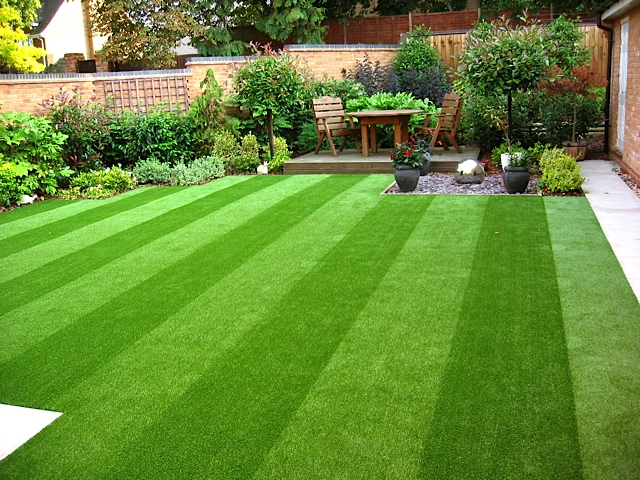DIY artificial grass installation is definitely feasible, and it can save you money while enhancing your skills. However, it requires a solid understanding of ground preparation, the right tools, and techniques to prevent issues like uneven surfaces or drainage problems. If you’re confident in your abilities, going the DIY route can be rewarding. But if you’re unsure of your experience or want the best results without the hassle, hiring professionals might be the smarter choice. Evaluating your comfort level and project complexity will help you determine. There’s much more to reflect on before making your final decision.
Benefits of DIY Installation
Installing artificial grass yourself offers both cost savings and a rewarding sense of accomplishment. Whether you’re tackling a small backyard or a larger area, like a Gold Coast artificial grass installation, you can greatly reduce installation costs by skipping professional fees, allowing you to invest in higher-quality materials. Plus, you gain hands-on experience, enhancing your DIY skills.
By choosing artificial grass, you also contribute positively to the environment. It eliminates the need for harmful pesticides and reduces water usage, minimizing your overall environmental impact.
To keep your new lawn looking pristine, remember a few maintenance tips. Regularly remove debris, brush the fibers to maintain their upright position, and rinse with water to prevent dust accumulation. By doing this yourself, you’ll enjoy a lush, green lawn with minimal effort while knowing you’ve made an eco-friendly choice.
Challenges of DIY Installation
When you decide to install artificial grass yourself, you’ll face some challenges that can impact your project.
Proper ground preparation is vital, and you’ll need the right tools and equipment to get the job done effectively.
Without these essentials, your DIY efforts mightn’t yield the results you expect.

Proper Ground Preparation
Proper ground preparation is vital for a successful DIY artificial grass installation, as neglecting this step can lead to uneven surfaces and drainage issues.
Start by removing any existing grass, weeds, and debris. You’ll need to guarantee proper soil stability, which involves compacting the ground to prevent sinking over time.
Installing drainage systems is also essential; without them, water can pool beneath your grass, creating a soggy mess. After leveling the ground, consider adding a layer of crushed rock for extra stability and drainage.
This groundwork not only helps your artificial grass look better but also extends its lifespan. If you don’t have experience with these tasks, you might find this phase challenging, which could lead to costly mistakes.
Tools and Equipment Needed
Once you’ve prepared the ground, gathering the right tools and equipment becomes the next vital step in your DIY artificial grass installation.
You’ll need a utility knife for cutting the grass, a rake for leveling the surface, and a power compactor to guarantee a solid base. A tape measure is essential for precise measurements, while a trowel helps with any necessary adjustments.
Don’t forget a weed barrier to prevent growth beneath your grass. Understanding installation techniques is significant for a smooth process, so take the time to research those.
Cost Comparison: DIY Vs Professionals
Comparing the costs of DIY artificial grass installation to hiring professionals reveals significant differences that can impact your budget and project outcome.
When you go the DIY route, you’ll primarily pay for installation materials like grass rolls, adhesives, and infill, which can be more cost-effective upfront. However, consider that you may face higher maintenance costs down the line if the installation isn’t done correctly.
On the other hand, hiring professionals often means higher initial expenses, but you’ll benefit from their expertise, potentially reducing future upkeep needs.
Ultimately, weigh the initial savings against the potential long-term costs. Your choice should reflect not just your budget but also your confidence in handling the installation process effectively.
Tools and Materials Needed
To successfully install artificial grass yourself, you’ll need a specific set of tools and materials to guarantee the project goes smoothly.
Start with a shovel, rake, and utility knife for shaping and cutting the grass. You’ll also need a roller to compact the base and make sure proper drainage.
Don’t forget a landscape fabric to prevent weeds and a good quality adhesive for seams.
For installation techniques, a straight edge or chalk line will help you achieve clean cuts and alignments.
Finally, consider having a broom handy for maintenance tips, as you’ll want to brush the grass regularly to keep it looking fresh.
With the right tools and materials, your DIY project can be a success!
Professional Installation Advantages
Choosing professional installation for your artificial grass not only saves you time but also guarantees a high-quality finish that enhances your outdoor space.
Professionals bring expertise that DIYers might lack, securing superior results. Here are three advantages to take into account:
- Advanced Installation Techniques: Experts know the best methods for laying artificial grass, resulting in a seamless look that’s difficult to achieve on your own.
- Guaranteed Durability: With their experience, professionals ensure your grass withstands wear and tear, preventing future issues.
- Maintenance Tips: They provide personalized advice on keeping your artificial grass in top shape, extending its lifespan and performance.
Final Considerations and Recommendations
Before you jump into your DIY artificial grass project, it’s important to weigh the costs against the benefits.
Consider your skill level honestly, as this will impact the quality of your installation.
Taking the time to assess these factors can save you headaches down the road.
Cost-Benefit Analysis
When weighing the costs and benefits of installing artificial grass, it’s essential to contemplate both the long-term savings and the immediate financial outlay.
Investing in DIY installation might save you money upfront, but you should consider the following factors before deciding:
- Initial Costs: Assess the cost of materials and tools needed for installation.
- Maintenance Costs: While artificial grass requires less upkeep than natural grass, factor in any potential repairs or replacements.
- Longevity: Consider how long the grass will last and the savings on water and lawn care over time.
Ultimately, determining if DIY is the right choice hinges on your budget, willingness to invest time, and the value you place on long-term savings versus immediate costs.
Skill Level Assessment
Evaluating your skill level is essential to ensuring a successful DIY artificial grass installation, as it directly impacts the quality of your finished project.
Consider your experience level with similar home improvement tasks. If you’ve tackled complex projects before, you might be well-equipped to handle this one. However, if you’re new to landscaping or working with materials like turf, the project complexity might overwhelm you.
Remember, the more intricate your design—like incorporating curves or different textures—the more skill and precision you’ll need. If you feel uncertain about any aspect, don’t hesitate to consult professionals.
Balancing your comfort and competence with the project’s demands will help you decide whether to go DIY or hire experts for the job.
